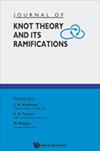自对偶映射III:投射链接
IF 0.3
4区 数学
Q4 MATHEMATICS
引用次数: 2
摘要
本文给出了链接是射影的充要组合条件,即$RP^3$中的链接。这种表征与反足自对偶和反足对称映射的概念密切相关。我们还讨论了对称环的概念,这是投影链接中出现的一个有趣的问题,使我们得到了一个简单的条件来防止投影链接是交替的。本文章由计算机程序翻译,如有差异,请以英文原文为准。
Self-Dual Maps III: Projective Links
In this paper, we present necessary and sufficient combinatorial conditions for a link to be projective, that is, a link in $RP^3$. This characterization is closely related to the notions of antipodally self-dual and antipodally symmetric maps. We also discuss the notion of symmetric cycle, an interesting issue arising in projective links leading us to an easy condition to prevent a projective link to be alternating.
求助全文
通过发布文献求助,成功后即可免费获取论文全文。
去求助
来源期刊
CiteScore
0.80
自引率
40.00%
发文量
127
审稿时长
4-8 weeks
期刊介绍:
This Journal is intended as a forum for new developments in knot theory, particularly developments that create connections between knot theory and other aspects of mathematics and natural science. Our stance is interdisciplinary due to the nature of the subject. Knot theory as a core mathematical discipline is subject to many forms of generalization (virtual knots and links, higher-dimensional knots, knots and links in other manifolds, non-spherical knots, recursive systems analogous to knotting). Knots live in a wider mathematical framework (classification of three and higher dimensional manifolds, statistical mechanics and quantum theory, quantum groups, combinatorics of Gauss codes, combinatorics, algorithms and computational complexity, category theory and categorification of topological and algebraic structures, algebraic topology, topological quantum field theories).
Papers that will be published include:
-new research in the theory of knots and links, and their applications;
-new research in related fields;
-tutorial and review papers.
With this Journal, we hope to serve well researchers in knot theory and related areas of topology, researchers using knot theory in their work, and scientists interested in becoming informed about current work in the theory of knots and its ramifications.

 求助内容:
求助内容: 应助结果提醒方式:
应助结果提醒方式:


